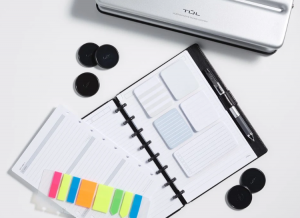Understanding how your mind prefers to work helps you find the right tools so that you can nurture your creativity.
Writing last week’s newsletter reminded me of a transformative moment in my writing life when, in April 2017, I discovered the existence of the disc-bound notebook. My husband and I were walking around Office Depot in Sheboygan when I first saw the T?l ‘customer note-taking system’ wherein a disc with a T-shaped lip holds paper that’s been punched with a similar T-shaped slot. I bought a book and refills there and then, and eventually bought more books, discs and even a T?l hole punch.
It was genuinely revolutionary.
Now, this is going to sound utterly ridiculous, but for many years my writing was hampered by the horribly linear nature of notebooks. No, really.
As I wrote back then:
Disorganised notes make me profoundly uncomfortable, to the point of causing creative paralysis, but there’s no functional way I can experience ideas in an organised manner. This means that traditional bound notebooks will always suffer not just from a lack of organisation but also negative emotional weight that’s hard to ignore. It’s just not possible to know how many pages to leave for a particular section: leave too many and it will feel like wasted space; leave too few and thematically related passages become separated and one has to search for and flip between pages when reading back over notes.
My mind is a disorganised creature that craves order. Traditional notebooks emphasise disorder and that caused a creative block that I found difficult to get around.
This became painfully evident last year when I discovered a trove of notebooks, each one containing the beginning of a novel or short story, or notes for same. In some cases, I’d left blank pages between sections of notes, trying to anticipate how much room I’d need for each topic. But each had been abandoned unfinished, the strictures of linear writing having strangled most of my ideas shortly after birth.
But when I discovered T?l, I no longer had to think about how many blank pages to leave because I could insert a page at will. I could take the entire notebook apart and re-bind it in a totally different order, if I wanted to. And that was immensely liberating.
(I am aware that I could have achieved the same thing with a ring-binder, but for some reason my subconscious doesn’t like ring-binders, possibly because I associate them with study.)
My use of my T?l notebooks has ebbed away over the last few years as Notability on the iPad has taken its place. But it’s exactly the same experience. I can create as many new documents in Notability as I like, and I can shuffle them about however I see fit. Because Notability allows for handwritten notes, I can scribble and draw diagrams and do whatever I would normally do on paper, and it’s available not just on my iPad but on every one of my devices that is capable of running Notability.
The bottom line here is not that T?l notebooks or Notability are some kinda of global panacea for all your note taking needs, it’s that you have to understand how your brain works and then find the tools to support it. You can’t fight the currents of your brain’s own flow, you have to find a way to swim with the rip tide.
As much as I love stationery – and I really do love stationery – the most beautiful notebooks in the world can’t help me if my brain is scared of ruining them by not writing linearly in them. About a decade ago, I did a bookbinding workshop where I made a gorgeous red leather notebook. It is exquisite. I will never, ever use it, because nothing I can write will ever live up to its physical beauty. So instead, I simply admire it for the work of art it is and I take my notes and write my stories elsewhere.
The lesson here is to experiment. If beautiful notebooks are too gorgeous to use, buy a cheap, scruffy one. If linear notebooks alarm your subconscious, use a disc-bound system. If writing notes on paper doesn’t work, try jotting them down on your phone. If writing doesn’t work, try using a voice memo app.
Your brain is in charge here. Learn how it works, what it likes, what it dislikes, and tailor your tools and processes to please it, because when your brain is happy, creativity becomes so much easier.






Comments on this entry are closed.